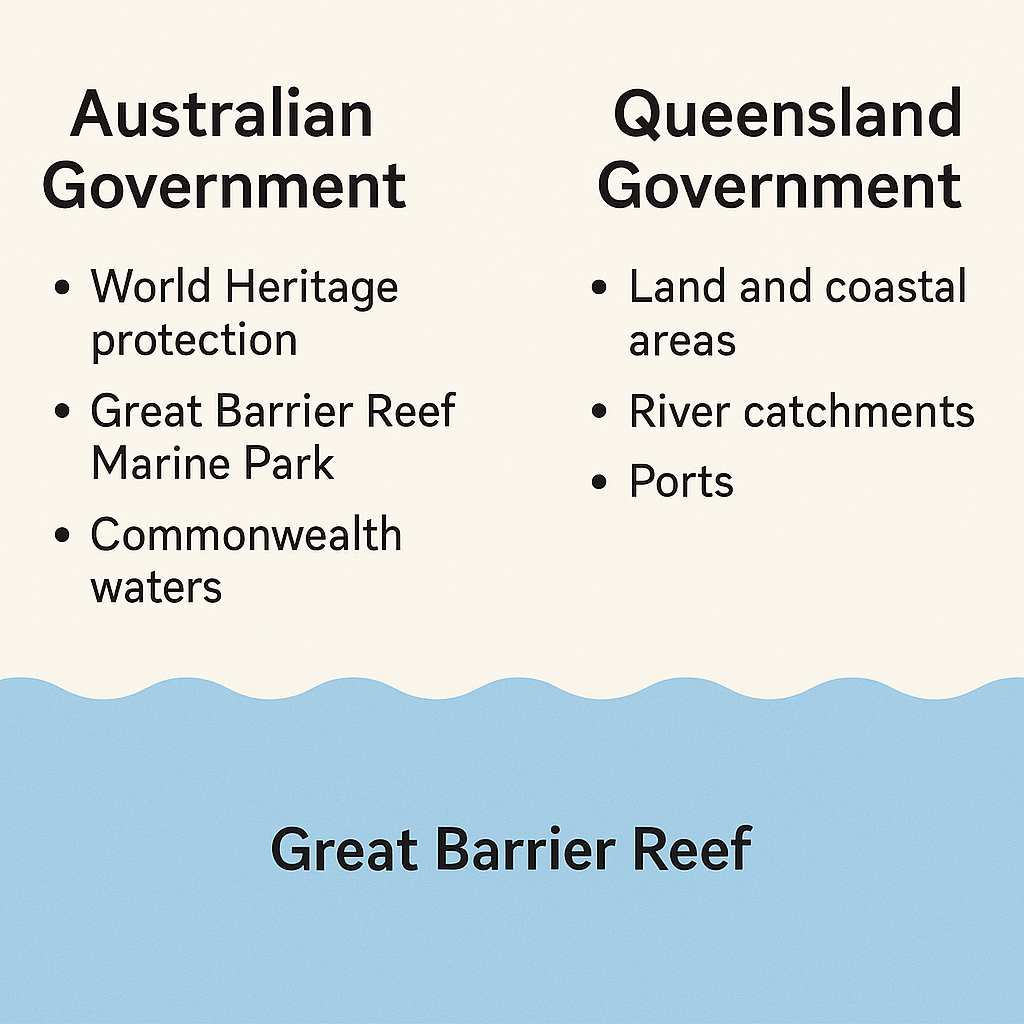To do: Create a GBR case study that examines threats to the GBR
Key question: Is the health of the GBR threatened by development.
The Great Barrier Reef (GBR) is one of the world's most iconic landforms.
Human activities including tourism, agriculture and harbour development threaten the ecology of the reef
In this project we will investigate the threats to the Great Barrier Reef, including the possible impacts of development of a coal seam gas loading facility at Gladstone harbour.
Part 1. Introduction to the GBR
Use an annotated map to explain the location of the Great Barrier Reef (GBR)
Use quotes from the sources to explain why the GBR is important: Consider environmental and cultural reasons.
Explain which Australian governments are responsible for protecting the GBR.
Part 2. Threats to the GBR
In this section
Use the following key questions and resources to describe some of the serious threats to the GBR.
What are the key threats to the GBR according to greatbarrierreef.com.au
Threats to the GBR - greatbarrierreef.com.au
The influence of mankind combined with various cyclical and natural factors have created cause for concern amongst both biologists and conservationist groups who do not want to see this precious natural miracle fall into decline.
How is fishing damaging the reef?
Threats highlighted in the GBRMPA statement on fishing include the alarming accidental catch and death of endangered wildlife from archaic practices such as gill netting, overfishing, illegal fishing and damage to fragile ocean habitats from trawling.
How does land based pollution impact the reef?
How does land-based pollution threaten coral reefs? - NOS
Impacts from land-based sources of pollution—including coastal development, deforestation, agricultural runoff, and oil and chemical spills—can impede coral growth and reproduction, disrupt overall ecological function, and cause disease and mortality in sensitive
What is causing coral bleaching and why is this an issue.
Explain why independentaustralia.net believes that the ‘reef is doomed’?
The reef is doomed!! - independentaustralia.net
The Great Barrier Reef is unlikely to survive climate change as more than a small, sad remnant of its past glory. (Maybe)
Part 3. The Gladstone development
Use the following key questions and resources to describe the possible threats to the GBR from the development of Gladstone Harbour for gas exports.
In this section.
Use maps to show the location of the Gladstone Harbour development and its proximity to the GBR.
List the reasons activists are concerned about the development of the port facility.
How will the dredging works for the new development impact the reef and the breeding grounds of many sensitive species?
Reasons activists are against the development.
The port of Gladstone is close to the world heritage listed GBR marine park. Conservationists are concerned that the harbour development will damage the reef. The development of the gas loading facility requires that large amounts of mud are dredged from the harbour to make it large enough to dock the ships that will carry the coal seam gas to customers in Asia.
Plans to expand several ports along the coastline will further damage our already vulnerable Reef. Port expansion plans require dredging of the seafloor, and will lead to a sharp increase in ship traffic crossing through our Reef’s waters. Just one collision, one mistake, or one spill could result in an environmental catastrophe in one of the seven natural wonders of the world.
Many of the areas that are dredged are feeding and breeding grounds for turtles, dugongs and other sensitive species.
Part 4. Counter argument - is the Gladstone development dredging safe?
In this section.
How far are the dredging disposal sites from the GBR, does this mean it isn’t a problem?
What is the evidence that the dredged material is not dangerous for the reef?
Great Barrier Reef Dredging Myths - The Conversation
'The debate about Abbot Point has been marked by considerable misinformation, including claims about “toxic sludge”, dumping coal on the reef and even mining the reef. Late last week, it was confirmed that our decision to allow the dredge disposal will be challenged in court.
The reality is that disposal of dredge material of this type in the Marine Park is not new. It has occurred off nearly all major regional centres along the reef’s coastline before now.
It is a highly regulated activity and does not allow material to be placed on coral, seagrass or sensitive marine environments. The material itself in Abbot Bay is about 60% sand and 40% silt and clay, which is similar to what you would see if you dug up the site where the material is to be relocated.
In addition, testing by accredited laboratories shows the material is not toxic, and is therefore suitable for ocean disposal.
Part 5. The civics of GBR conservation - Letter to the Minister
The Queensland Government (State) manages the land and coastal areas adjoining the reef, including river catchments that affect water quality. The state government also oversees ports, agriculture, and coastal development that influence runoff and pollution into the reef.
In this section.
In your role as a Geography GBR expert, write a letter to the Queensland Environment Minister explaining your concerns about the threats to the GBR and reminding her of her governments responsibilities.
In your letter, highlight the potential threats to the GBR from the Gladstone development.



